Traffic Deaths Increasingly Involve Pedestrians
Pedestrian deaths a rising share of traffic fatalities nationally and in Wisconsin. Why?
Pedestrian deaths rose 10 percent in the first half of 2015 compared to the same period the year before, according to preliminary data released by the Governors Highway Safety Association. If that increase held up over all 12 months of 2015, it would be among the worst single-year changes since the GHSA started collecting data in 1975.
In a typical year, nearly 5,000 Americans are killed while walking. While fatalities for car occupants have been dropping, pedestrian fatalities have not. As a result, pedestrian deaths now make up about 15 percent of traffic fatalities, compared to 11 percent a decade ago, according to the GHSA.
In Wisconsin, pedestrian deaths haven’t been rising. according to data from the state Department of Transportation. The number of such fatalities was exactly the same, at 42 in 2005 and 2014. However, the data shows the total number of traffic fatalities plummeted, from 801 in 2005 to 498 in 2014. As a result, pedestrian deaths now account for 8.4 percent of all deaths, compared to 5.2 percent back in 2005.
Nationally, too, the rise pedestrian deaths as a percentage of all motor vehicle deaths reflects the reduction in the total number of deaths. But why aren’t pedestrian deaths declining as well? The best we have are educated guesses. Of course, you’ll also see some wild and irresponsible victim-blaming in the media. Here are some of the potential explanations that have been put forth and some thoughts on how seriously to take them.
People are walking more. About 1 million more people walked to work in 2013 than in 2005, according to Census data cited by GHSA. That’s a 21 percent increase.
Keep in mind, though, that the Census doesn’t measure total walking volumes — it just counts commuters. So while it seems like people are probably walking more overall, the lack of good data makes it difficult to know with certainty.
So people are cruising around in air bag-equipped cars with anti-lock brakes, their children cocooned in the latest car seat — and when they crash, they’re more likely to survive. But vehicle technology hasn’t adapted in ways that help pedestrians, who remain as vulnerable as ever. If you’re a techno-optimist, self-driving cars are the innovation that will change this, but they’re still several years away from hitting the market.
People are driving more. The more people drive, the more people are exposed to the risk of fatal crashes. This is a fairly unassailable contributing factor in recent years. Driving trips increased 3.5 percent in the first half of 2015, according to the Federal Highway Administration.
Distracted drivers. Smartphones, in-dash displays, and other devices present more opportunities to stop paying attention to the task of driving. More than 3,000 people are killed in distracted driving crashes annually, although data more recent than 2013 is not yet available, so there’s no way to firmly assess the role of driver distraction in the rise of pedestrian deaths.
Distracted pedestrians. Some media outlets have been very heavy-handed in assigning blame to “distracted pedestrians.” This report from Indianapolis’s WIVB is a great example. There’s typically no evidence presented to support the theory except for anecdotes about people texting and walking. As Alissa Walker at Gizmodo put it, cell phones don’t kill pedestrians, cars do.
“Forgiving” road design. Road design doesn’t change much in a single year. But the engineering practice of using highway design standards in urban areas may have contributed to the long-term failure to improve pedestrian fatality rates.
Examples of “forgiving design” include wide traffic lanes and “clear zones” free of trees and other obstacles on the roadside. These features are designed to give drivers more room for error, but they also encourage fast driving and inattention, putting pedestrians at risk.
GHSA, for its part, does recommend road diets and other street design fixes to address the problem.
Story by Angie Schmitt with additions by Urban Milwaukee. A version of this story originally ran on Streetsblog. Angie Schmitt is a newspaper reporter-turned planner/advocate who manages the Streetsblog Network from glamorous Cleveland, Ohio. She also writes about urban issues particular to the industrial Midwest at Rustwire.com.
Streetsblog
-
Car Culture Cements Suburban Politics
![Sprawl. Photo by David Shankbone (David Shankbone) [GFDL (http://www.gnu.org/copyleft/fdl.html) or CC-BY-SA-3.0 (http://creativecommons.org/licenses/by-sa/3.0/)], via Wikimedia Commons [ https://commons.wikimedia.org/wiki/File%3ASuburbia_by_David_Shankbone.jpg ]](https://urbanmilwaukee.com/wp-content/uploads/2017/10/1024px-Suburbia_by_David_Shankbone-185x122.jpg) Nov 23rd, 2018 by Angie Schmitt
Nov 23rd, 2018 by Angie Schmitt
-
Most Drivers Don’t Yield to Pedestrians
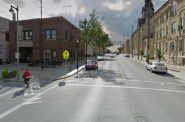 Mar 22nd, 2018 by Angie Schmitt
Mar 22nd, 2018 by Angie Schmitt
-
Jobs Up Yet Driving Down in Seattle
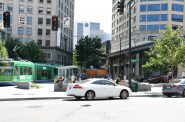 Feb 22nd, 2018 by Angie Schmitt
Feb 22nd, 2018 by Angie Schmitt
Transportation
-
Paper Table Has Plan to Address Double-Parking
 Apr 9th, 2024 by Sophie Bolich
Apr 9th, 2024 by Sophie Bolich
-
Just How Bad Are Milwaukee’s Roads?
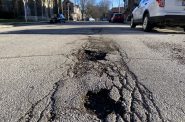 Apr 7th, 2024 by Graham Kilmer
Apr 7th, 2024 by Graham Kilmer
-
MPS Makes the Case for Referendum
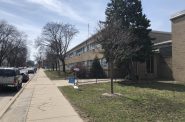 Mar 23rd, 2024 by Graham Kilmer
Mar 23rd, 2024 by Graham Kilmer


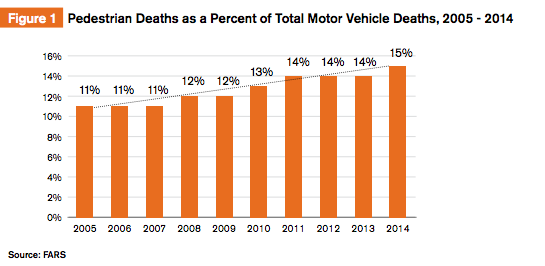















Angie, thank you for writing about this topic. Has there been any changes in how often police enforce laws mandating cars stop at crosswalks when pedestrians are present? While I see signs, say on Brady St., reminding drivers of these state cross walk laws I rarely see them stop even when pedestrians are already in the street. Changing infrastructure to make safer streets seems far more expensive and a larger political lift to achieve than simply having greater enforcement of the pedestrian safety laws we already have on the books.
The way streets are built and rebuilt, especially in the innercity, needs to be rethought. There have been improvements but it seems most of these improvements have been on streets that are on the up swing.
I’d love to see bump outs, colored bike lanes and narrow auto traffic lanes on the Northside thoroughfares.
My personal order of preference: FDL, 27th, Capitol, King, Center, Burleigh, Hampton, Villard and sections of Silver Spring.
Also stricter traffic enforcement. Not all stops need to result in a fine, just the inconvenience of being stopped I think will deter most. Of course if you’re stopped more than once during a certain period you should receive a fine.
I’d suggest that curb bump outs (and bus bulbs), colored and buffered bike lanes, better marked (and in some cases, raised) crosswalks, and narrowed traffic lanes should be standard practice in much of the city whenever streets are rebuilt. It is vitally important to improve the pedestrian experience if the city is to leverage its investment in the streetcar, for example.
Enforcement of traffic laws is certainly an important part as well. Ideally, this would include red light cameras and speed cameras, but as that would require a change in state law, I can’t see that happening anytime soon. But enforcement only does so much. Ultimately drivers take cues from the built environment – build streets for cars to be driven quickly and that’s what we’ll get; build streets for people (on foot, on bike, on transit, in cars), and the streets themselves will in some ways be self-enforcing.
Yes, to completely reconstruct streets citywide would be incredibly expensive and is unrealistic. But, the city ought to adopt the practice of redesigning streets to consider pedestrians and transit first whenever streets are reconstructed. And, some changes can be made relatively cheaply – re-striping lanes to be narrower and using stripes and planters (or something similar) to narrow corners is relatively inexpensive.